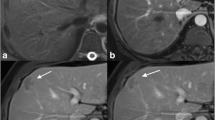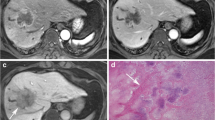Abstract
Purpose
To determine the differential MRI features of small mass-forming intrahepatic cholangiocarcinoma (ICC) from hepatocellular carcinoma (HCC).
Methods
Sixty-four patients with pathologically proven small ICCs (n = 32) and HCCs (n = 32) (≤3.0 cm in diameter) who had undergone preoperative gadoxetic acid-enhanced MRI and DWI were enrolled in this study. Images were analyzed for the shape of the lesions, the presence of biliary dilatation, hyperenhancement (>50 % of the tumor volume) or rim enhancement on the arterial phase, capsular enhancement, and the presence of target appearance (a central enhancement with hypointense rim) on the hepatobiliary phase and on DWI (a central hypointense area with a peripheral hyperintense rim). Statistical significance of these findings was determined by the χ2 or Fisher’s exact test. Multivariate analysis was performed to identify independent imaging findings that allow differentiation of the two diseases.
Results
Univariate analysis revealed that the following significant parameters favor ICC over HCC: lobulating shape, rim enhancement on arterial phase, target appearance on the hepatobiliary phase, and DWI (P < 0.05). Multivariate logistic regression analysis revealed that only target appearance on the DWI was a significant and independent variable predictive of ICC, as 24 ICCs (75.0 %) and one HCC (3.1 %) showed this feature (P = 0.0003).
Conclusion
A target appearance on the DWI was the most reliable imaging feature for distinguishing small mass-forming ICC from small HCC.





Similar content being viewed by others
References
Kham SA, Thomas HC, Davidson BR, Taylor-Robinson SD (2005) Cholangiocarcinoma. Lancet 366:1303–1314
Patel T (2001) Increasing incidence and mortality of primary intrahepatic cholangiocarcinoma in the United States. Hepatology 33:1353–1357
Shaib Y, El-Serag HB (2004) The epidemiology of cholangiocarcinoma. Semin Liver Dis 24:115–125
Lim JH (2003) Cholangiocarcinoma: morphologic classification according to growth pattern and imaging findings. AJR Am J Roentgenol 181:819–827
Choi BI, Han JK, Shin YM, Baek SY, Han MC (1995) Peripheral cholangiocarcinoma: comparison of MRI with CT. Abdom Imaging 20:357–360
Fan ZM, Yamashita Y, Harada M, et al. (1993) Intrahepatic cholangiocarcinoma: spin-echo and contrast-enhanced dynamic MR imaging. AJR Am J Roentgenol 161:313–317
Hamrick-Turner J, Abbitt PL, Ros PR (1992) Intrahepatic cholangiocarcinoma: MR appearance. AJR Am J Roentgenol 158:77–79
Maetani Y, Itoh K, Watanabe C, et al. (2001) MR imaging of intrahepatic cholangiocarcinoma with pathologic correlation. AJR Am J Roentgenol 176:1499–1507
Tani K, Kubota Y, Yamaguchi T, et al. (1991) MR imaging of peripheral cholangiocarcinoma. J Comput Assist Tomogr 15:975–978
Vilgrain V, Van Beers BE, Flejou JF, et al. (1997) Intrahepatic cholangiocarcinoma: MRI and pathologic correlation in 14 patients. J Comput Assist Tomogr 21:59–65
Rimola J, Forner A, Reig M, et al. (2009) Cholangiocarcinoma in cirrhosis: absence of contrast washout in delayed phases by magnetic resonance imaging avoids misdiagnosis of hepatocellular carcinoma. Hepatology 50:791–798
Vilana R, Forner A, Bianchi L, et al. (2010) Intrahepatic peripheral cholangiocarcinoma in cirrhosis patients may display a vascular pattern similar to hepatocellular carcinoma on contrast-enhanced ultrasound. Hepatology 51:2020–2029
Kim SA, Lee JM, Lee KB, et al. (2011) Intrahepatic mass-forming cholangiocarcinomas: enhancement patterns at multiphasic CT, with special emphasis on arterial enhancement pattern-correlation with clinicopathologic findings. Radiology 260:148–157
Kim SJ, Lee JM, Han JK, et al. (2007) Peripheral mass-forming cholangiocarcinoma in cirrhotic liver. AJR Am J Roentgenol 189:1428–1434
El-Serag HB, Engels EA, Landgren O, et al. (2009) Risk of hepatobiliary and pancreatic cancers after hepatitis C virus infection: a population-based study of U.S. veterans. Hepatology 49:116–123
Bruix J, Sherman M, American Association for the Study of Liver Disease (2011) Management of hepatocellular carcinoma: an update. Hepatology 53:1020–1021
Bruix J, Sherman M, Llovet JM, et al. (2001) Clinical management of hepatocellular carcinoma. Conclusions of the Barcelona-2000 EASL conference. European Association for the Study of the Liver. J Hepatol 35:421–430
Kim YK, Kim CS, Han YM, Park G (2010) Detection of small hepatocellular carcinoma: can gadoxetic acid-enhanced magnetic resonance imaging replace combining gadopentetate dimeglumine-enhanced and superparamagnetic iron oxide-enhanced magnetic resonance imaging? Invest Radiol 45:740–746
Kim SH, Kim SH, Lee J, et al. (2009) Gadoxetic acid-enhanced MRI versus triple-phase MDCT for the preoperative detection of hepatocellular carcinoma. AJR Am J Roentgenol 192:1675–1681
Kim YK, Kim CS, Han YM, et al. (2009) Detection of hepatocellular carcinoma: gadoxetic acid-enhanced 3-dimensional magnetic resonance imaging versus multi-detector row computed tomography. J Comput Assist Tomogr 33:844–850
Taouli B, Koh DM (2010) Diffusion-weighted MR imaging of the liver. Radiology 254:47–66
Kim YK, Lee MW, Lee WJ, et al. (2012) Diagnostic accuracy and sensitivity of diffusion-weighted and gadoxetic acid-enhanced 3-T MR imaging alone or in combination in the detection of small liver metastasis (≤1.5 cm in diameter). Invest Radiol 47:159–166
Bolondi L, Gaiani S, Celli N, et al. (2005) Characterization of small nodules in cirrhosis by assessment of vascularity: the problem of hypovascular hepatocellular carcinoma. Hepatology 42:27–34
Holland AE, Hecht EM, Hahn WY, et al. (2005) Importance of small (< or = 20-mm) enhancing lesions seen only during the hepatic arterial phase at MR imaging of the cirrhotic liver: evaluation and comparison with whole explanted liver. Radiology 237:938–944
Kim YK, Lee JM, Kim CS (2004) Gadobenate dimeglumine-enhanced liver MR imaging: value of dynamic and delayed imaging for the characterization and detection of focal liver lesions. Eur Radiol 14:5–13
Tamada T, Ito K, Sone T, et al. (2009) Dynamic contrast-enhanced magnetic resonance imaging of abdominal solid organ and major vessel: comparison of enhancement effect between Gd-EOB-DTPA and Gd-DTPA. J Magn Reson Imaging 29:636–640
Gabata T, Matsui O, Kadoya M, et al. (1998) Delayed MR imaging of the liver: correlation of delayed enhancement of hepatic tumors and pathologic appearance. Abdom Imaging 23:309–313
Kim YK, Han YM, Kim CS (2009) Comparison of diffuse hepatocellular carcinoma and intrahepatic cholangiocarcinoma using sequentially acquired gadolinium-enhanced and Resovist-enhanced MRI. Eur J Radiol 70:94–100
Conflict of interest
I certify that all authors have had no relevant financial interests or personal affiliations in connection with the content of this manuscript.
Author information
Authors and Affiliations
Corresponding author
Rights and permissions
About this article
Cite this article
Park, H.J., Kim, Y.K., Park, M.J. et al. Small intrahepatic mass-forming cholangiocarcinoma: target sign on diffusion-weighted imaging for differentiation from hepatocellular carcinoma. Abdom Imaging 38, 793–801 (2013). https://doi.org/10.1007/s00261-012-9943-x
Published:
Issue Date:
DOI: https://doi.org/10.1007/s00261-012-9943-x




